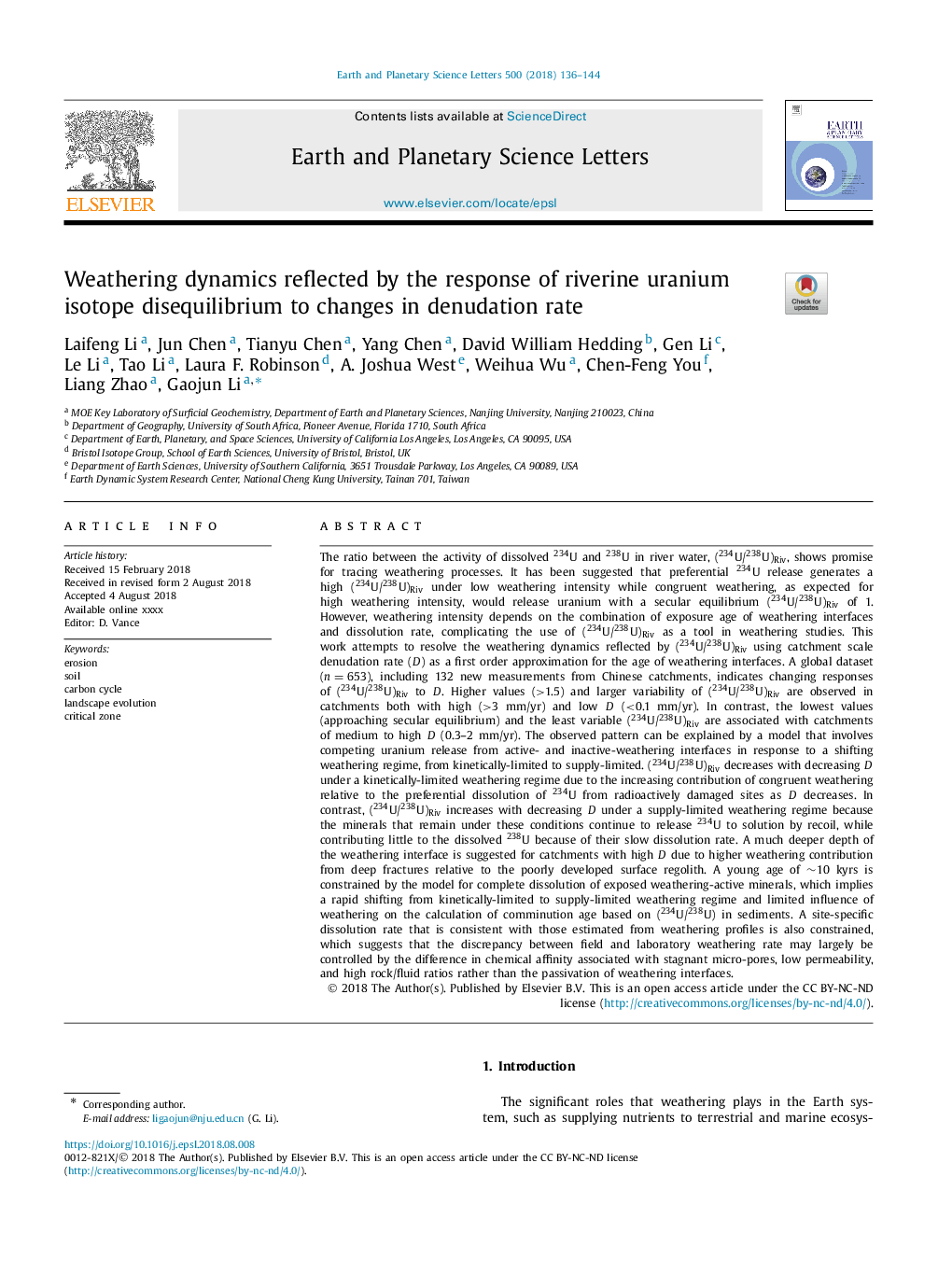| کد مقاله | کد نشریه | سال انتشار | مقاله انگلیسی | نسخه تمام متن |
|---|---|---|---|---|
| 8906662 | 1634656 | 2018 | 9 صفحه PDF | دانلود رایگان |
عنوان انگلیسی مقاله ISI
Weathering dynamics reflected by the response of riverine uranium isotope disequilibrium to changes in denudation rate
ترجمه فارسی عنوان
دینامیک آب و هوا منعکس شده توسط پاسخ عدم تعادل ایزوتوپ رودخانه ای اورانیم به تغییرات میزان دندانه سازی
دانلود مقاله + سفارش ترجمه
دانلود مقاله ISI انگلیسی
رایگان برای ایرانیان
کلمات کلیدی
فرسایش، خاک، چرخه کربن، تکامل چشم انداز، منطقه بحرانی،
موضوعات مرتبط
مهندسی و علوم پایه
علوم زمین و سیارات
علوم زمین و سیاره ای (عمومی)
چکیده انگلیسی
The ratio between the activity of dissolved 234U and 238U in river water, (234U/238U)Riv, shows promise for tracing weathering processes. It has been suggested that preferential 234U release generates a high (234U/238U)Riv under low weathering intensity while congruent weathering, as expected for high weathering intensity, would release uranium with a secular equilibrium (234U/238U)Riv of 1. However, weathering intensity depends on the combination of exposure age of weathering interfaces and dissolution rate, complicating the use of (234U/238U)Riv as a tool in weathering studies. This work attempts to resolve the weathering dynamics reflected by (234U/238U)Riv using catchment scale denudation rate (D) as a first order approximation for the age of weathering interfaces. A global dataset (n=653), including 132 new measurements from Chinese catchments, indicates changing responses of (234U/238U)Riv to D. Higher values (>1.5) and larger variability of (234U/238U)Riv are observed in catchments both with high (>3 mm/yr) and low D (<0.1 mm/yr). In contrast, the lowest values (approaching secular equilibrium) and the least variable (234U/238U)Riv are associated with catchments of medium to high D (0.3-2 mm/yr). The observed pattern can be explained by a model that involves competing uranium release from active- and inactive-weathering interfaces in response to a shifting weathering regime, from kinetically-limited to supply-limited. (234U/238U)Riv decreases with decreasing D under a kinetically-limited weathering regime due to the increasing contribution of congruent weathering relative to the preferential dissolution of 234U from radioactively damaged sites as D decreases. In contrast, (234U/238U)Riv increases with decreasing D under a supply-limited weathering regime because the minerals that remain under these conditions continue to release 234U to solution by recoil, while contributing little to the dissolved 238U because of their slow dissolution rate. A much deeper depth of the weathering interface is suggested for catchments with high D due to higher weathering contribution from deep fractures relative to the poorly developed surface regolith. A young age of â¼10 kyrs is constrained by the model for complete dissolution of exposed weathering-active minerals, which implies a rapid shifting from kinetically-limited to supply-limited weathering regime and limited influence of weathering on the calculation of comminution age based on (234U/238U) in sediments. A site-specific dissolution rate that is consistent with those estimated from weathering profiles is also constrained, which suggests that the discrepancy between field and laboratory weathering rate may largely be controlled by the difference in chemical affinity associated with stagnant micro-pores, low permeability, and high rock/fluid ratios rather than the passivation of weathering interfaces.
ناشر
Database: Elsevier - ScienceDirect (ساینس دایرکت)
Journal: Earth and Planetary Science Letters - Volume 500, 15 October 2018, Pages 136-144
Journal: Earth and Planetary Science Letters - Volume 500, 15 October 2018, Pages 136-144
نویسندگان
Laifeng Li, Jun Chen, Tianyu Chen, Yang Chen, David William Hedding, Gen Li, Le Li, Tao Li, Laura F. Robinson, A. Joshua West, Weihua Wu, Chen-Feng You, Liang Zhao, Gaojun Li,
